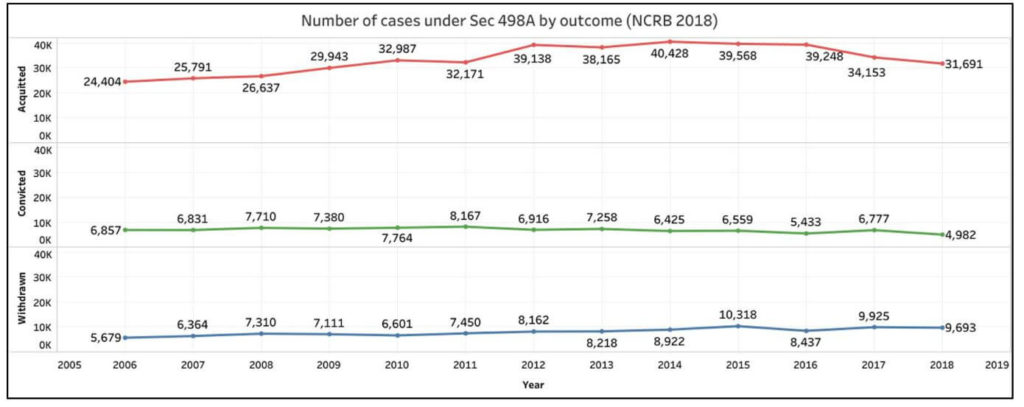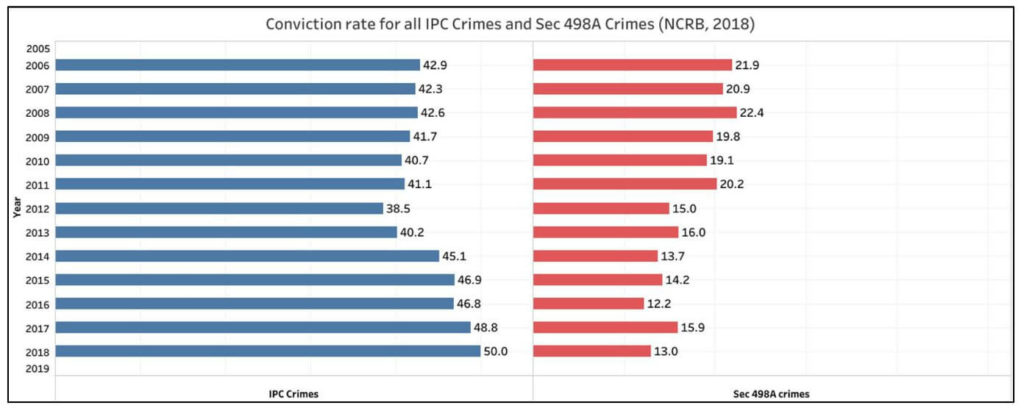The conviction rate of all IPC crimes reached 50% in 2018, the highest in 13 years. At the same time, the conviction rate of cases under Sec 498A has fallen and reached 13% in 2018, the 2nd lowest in 13 years.
Violence against women is a global problem. The United Nations adopted the ‘Declaration on the Elimination of Violence Against Women’ in 1993. Even in India, there are many legislations aimed at protecting the rights of women.
One such provision is Section 498A of the Indian Penal Code (IPC) that makes domestic violence and harassment women may be subjected to by husbands and their families for dowry-related matters a crime.
As per the 2018 report of the National Crime Records Bureau (NCRB), more than one lakh cases under Sec 498A were reported in India in 2018. These cases made up for 27.3% of all the cases of crime against women reported in 2018. This provision has been always been in the news with allegations of false complaints and very low conviction rate.
What is Section 498A?
In 1983, the government introduced this section through an amendment to the IPC to make acts of cruelty and harassment towards wife by her husband and in-laws a criminal offence. These acts can be emotional, physical, psychological, verbal or sexual. The objective of the amendment was to curb the increasing number of dowry deaths and harassment of wives leading to suicides, by penalising the offender.
Under this section, in case the husband or his family members is found guilty of harassing his wife, mentally or physically, they will be imprisoned for a period of up to three years, in addition to a penalty. The offence is cognizable, non-compoundable and non-bailable.

Over the many years, there have been allegations that the law was being misused by women by making false complaints or exaggerated allegations for frivolous cases. The Supreme Court has in different judgements acknowledged this misuse.
What are the various Supreme Court judgments?
In 2014, the Supreme Court of India ruled out automatic arrests under this section. The Court also issued some important directions to be followed while dealing with cases under this section.
After three years, in 2017, the Court further directed that family welfare committees at district level were to be set up by District Legal Services Authority to look into all the cases reported under Section 498A and submit their reports within a month, after which an investigation officer will be assigned to investigate the case. However, this judgement was later altered by the SC in 2018 after re-examination of the judgement. Since family welfare committees were extra-judicial committees, SC directed that these committees could not exercise statutory function. The other directions were retained.
The annual ‘Crime in India’ report of NCRB gives details of number of crimes reported under Section 498A along with the disposal by courts. While the number of cases registered under the section crossed 1.2 Lakhs in 2014, the number of cases registered has fallen since then and stood at 1.03 Lakhs in 2018 with almost 17,000 cases reported in West Bengal alone.
Number of cases pending under Section 498A has increased by 2.6 times in 13 years
The number of cases pending under Section 498A has steadily increased since 2006. From 2006 to 2017, an annual average increase of 10% was observed in the number of pending cases. In 2017, there was a drop in the number of cases. However, again in 2018, the number of pending cases under this section has risen by 6%. In the span of these thirteen years, the number of pending cases under 498A have more than doubled and increased by 161%.

Number of convictions in 2018 lowest in ten years
The number of convictions under this section between 2006 and 2017 varied between 6000 and 8000 a year except in 2016. The year 2018 has reported the least number of convictions under 498A between 2006 & 2018. Only 4982 convictions were reported in 2018.
Up to 2016, the number of acquittals under this section witnessed an increase of 60% compared to 2006. Since then, the number acquitted dropped to 34,153 in 2017 and to the lowest in the decade which is 31,691 in 2018.
During the same period, the number of cases withdrawn has gradually increased. Between 2006 and 2018, the number of cases withdrawn (or compromised) has increased by 70%.

Conviction rate falls to 13%
A comparison of the conviction rate of all IPC crimes and the cases under 498A reveals that the conviction rate of the cases under 498A has continuously reduced. Data reveals that in the case of all IPC crimes, the conviction rate dropped from 42.9% in 2006 to 38.5 in 2012. However, between 2013 and 2018, the rate has increased continuously to reach 50%. In other words, one out of every two cases under IPC, where trial has completed has resulted in a conviction.
On the other hand, the conviction rate of cases under 498A has drastically reduced from 21.9% in 2006 to 13% in 2018. Conviction rate of 498A cases in 2018 is almost a quarter of conviction rate of all IPC crimes. Only 1 out of 7 cases under Sec 498A resulted in a conviction in 2018.

Conviction rate for cases under 498A is the lowest among all IPC crimes
NCRB presents data for different IPC and SLL laws in the annual ‘Crime in India’ report. Up to 2013, data was presented under 23 categories of offences under IPC. This was increased to 34 categories in 2015. Following the modifications made to the 2017 report, data of crimes under IPC have been categorised into 55 categories.
While conviction rate of cases under Section 498A has been ranked among the bottom four in all the 13 years (2006 to 2018), it has been ranked the lowest in 4 different years and lowest but one in 5 different years. In 2018, it has been ranked 54 out of 55 categories.

Data insufficient to conclude misuse of Section 498A
Data indicates that while the highest number of FIRs are filed under Section 498A, the conviction rate is one of the lowest. However, to conclude that the section has been misused just because of the low conviction rate would be misleading.
There are many complexities around this law. The offence need not be explicit and need not have witnesses. The persistent social stigma also does not allow women to come forward and register complaints. Lack of awareness about the law is another factor. An in-depth analysis taking into consideration the causes of violence, social factors, the role of the police investigation is necessary to understand this dichotomy between high number of cases and the low conviction rate.
In addition to Section 498A, there is separate legislation, Protection of Women from Domestic Violence Act, 2005 to protect women from violence inflicted by partners.
With inputs from Prudhvi Potuganti
Featured Image: Section 498A



1 Comment
Laws are completely misused. Judiciary is hiding the truth, why cases suddenly withdrawn. If trial happened quickly conviction rate will be further low.